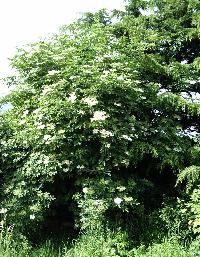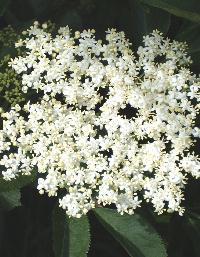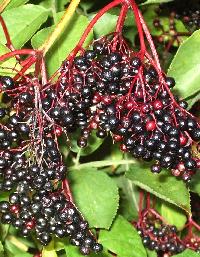Elder (Sambucus nigra)
By Lynne Tann-Watson
Other names: Black elder, Lady Ellhorn, pipe tree, whistle tree, Old Lady, bore tree, hylder.
Introduction

It used to be said that if you had an elder tree in the garden you had a medicine chest. I would extend that to say you also have a larder.
It is a native shrub or small tree which is found growing wild just about everywhere in Britain. The flat topped, cream flower heads appear in May and June followed by the purple-black berries in September.
Many people find the scent of the flowers unpleasant and liken it to the smell of cat urine.
The name Elder comes from the Anglo-Saxon word 'aeld' meaning fire, possibly due to the use of the hollow stems as a blow pipe to make a fire burn. The pith of the stems is easily pushed out and whistles were made from the hollow stems, the belief being that the sweetest sounding ones were made from trees that grew away from the sound of cock-crow. Pop guns were also made out of the stems by country children.
Folk law
There are many superstitions and folk tales surrounding elder. Judas was supposed to have hanged himself on an elder tree and the cross on which Jesus was crucified was said to have been made from elder wood.
Each elder tree is supposed to have a spirit in it, known as the 'elder Mother' and if wood is taken from the tree and used to make furniture, the Elder Mother will follow the wood and haunt it. It's also advisable to ask permission of the Elder Mother before picking the flowers, leaves or berries, or cutting branches, or bad luck will befall. There are still country people who won't cut elder in a hedge and certainly won't burn the wood.
If you stand under an Elder tree on Midsummer Eve, it is said that you will see the King of the Fairies ride by.
An elder growing by the door or gate of a house is supposed to keep witches and evil spirits away and it was planted in a herb garden to act as guardian to the other plants growing there.
An elder would be planted on new graves in Celtic times and if it blossomed, it was a sign that the departed was happy.

Cultivation
Elder grows so freely around the countryside that it isn't really necessary to cultivate it, but if you wish to do so, it's very easy to grow. Any twig of elder stuck in the ground will root and very quickly become a large bush. But take care where you put it because it grows very fast and can swamp other plants near by.
Part used: all parts
Culinary uses
The flowers can be used to make sweet syrups or to flavour jellies and ice-creams. They make a refreshing summer cordial and a light wine. Cooked with gooseberries or rhubarb they give a Muscat-like flavour. Fritters can also be made from the flowers.
The berries have many uses, in jams, jellies, sorbets and ice-creams, chutneys and pickles. They can be cooked with other fruit in pies and the dried berries can be used as a substitute for currants in baking. The finest of all the 'country' wines is elderberry and a cordial makes a wonderfully soothing winter drink if taken hot.
It's probably not advisable to use the berries raw as it has been know to cause stomach upsets in some people.

Medicinal uses
The leaves are used as an insect repellant and can be made into an ointment for use on bruises, sprains, chilblains and wounds. It is not recommended to take them internally as they are very strongly purgative.
The bark has been used for headaches and as a poultice and to promote labour in childbirth, though they are also strongly purgative and their internal use is no to be advised.
The flowers are used to make elderflower water, which is supposed to whiten and soften the skin and remove freckles. A tea is also a good expectorant and causes sweating so is good in cases of feverish colds and 'flu'. A soothing eye wash can be made from it and it is also soothing for skin eruptions and rashes.
The berries are a wonderful remedy for coughs, colds and 'flu' when taken as a tea, a cordial or as a tincture. In fact the tincture, if taken in teaspoonful doses three or four times a day at the first signs of a cold, may stop the cold from developing. If it does develop, it may be milder and for shorter duration if elderberry tincture is taken.
And finally
On top of all these uses, the bark and roots of elder will give a good black dye for wool or cloth, the leaves a green and the berries purple or blue. The Romans used the berries to make a black hair dye and ink has been made from them.
There are so many recipes using elder, that I await everyone's contribution to the forum with great interest!
